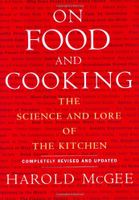Improvements in Flavor, Color, and Dispersability
By Harold McGee
Published 2004
Finally, the heat causes some of the starch chains to split, and then to form new bonds with each other. This generally means that long chains and branches are broken down into smaller pieces that then form short branches on other molecules. The short, branched molecules are less efficient at thickening liquids than the long chains, but they’re also slower to bond to each other and form a continuous network as the liquid cools. The sauce is therefore less prone to congeal on the plate. The darker the roux, the more starch chains are modified in this way, and so the more roux is required to create a given thickness. It takes more of a dark brown roux than a light one to thicken a given amount of liquid. (The industrial version of roux making to make a starch more dispersable and stable to cooling is called dextrinization, and involves heating dry starch together with some dilute acid or alkali to 375°F/190°C.)
Become a Premium Member to access this page
Unlimited, ad-free access to hundreds of the world’s best cookbooks
Over 160,000 recipes with thousands more added every month
Recommended by leading chefs and food writers
Powerful search filters to match your tastes
Create collections and add reviews or private notes to any recipe
Swipe to browse each cookbook from cover-to-cover
Manage your subscription via the My Membership page
Part of
Advertisement
Related Recipes
-
-
-
-
Related Reference
-
-
-
-
Advertisement



